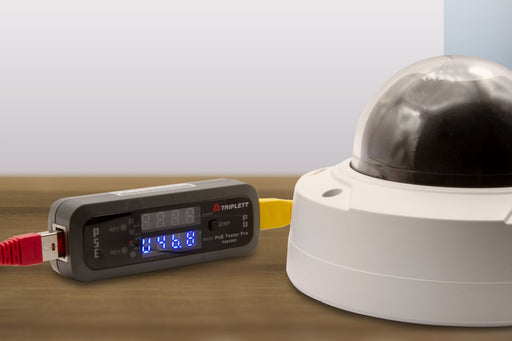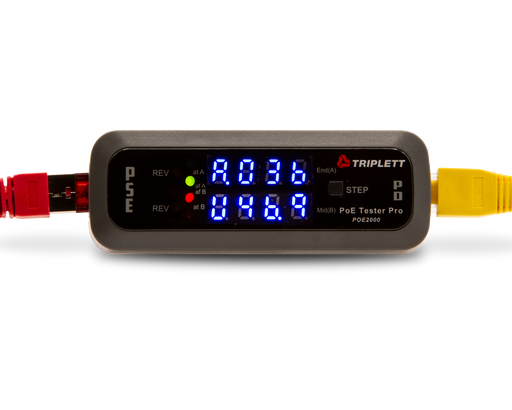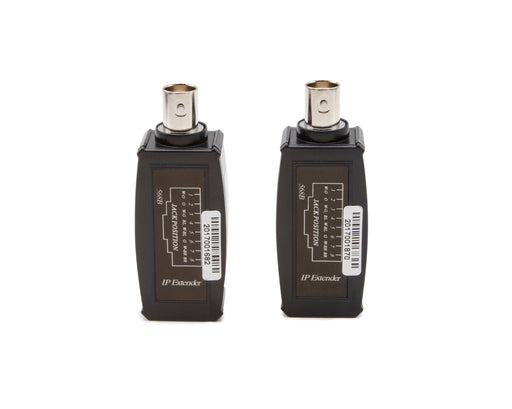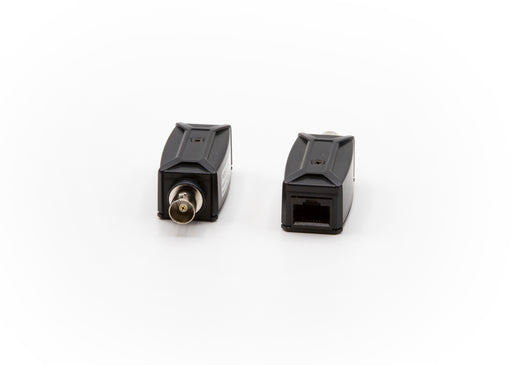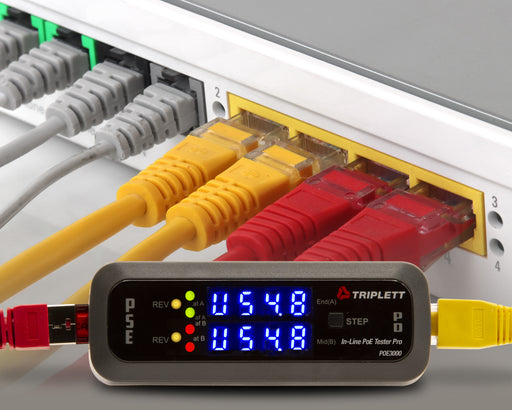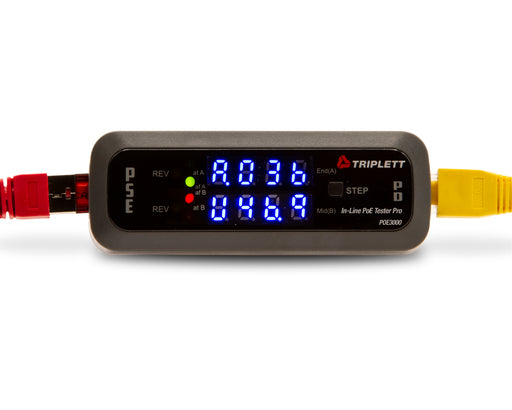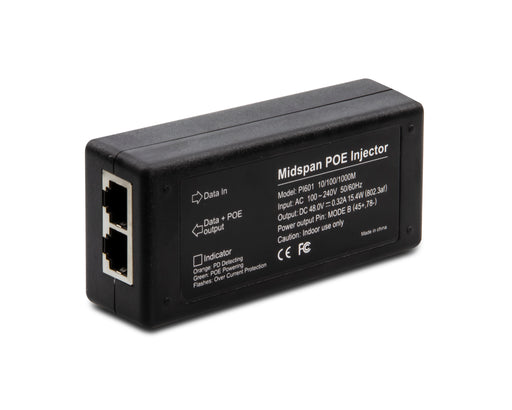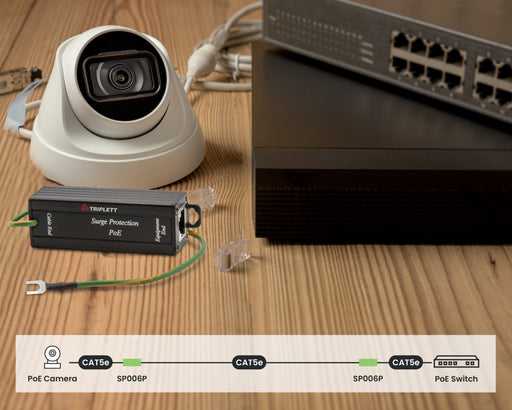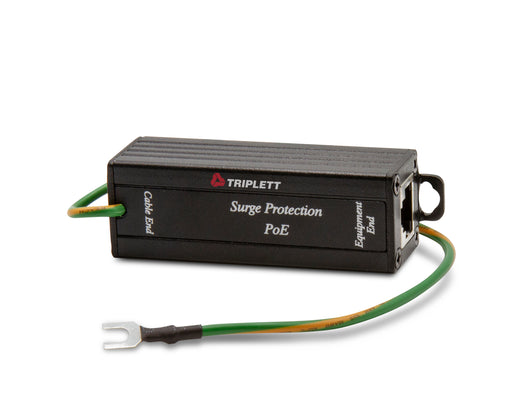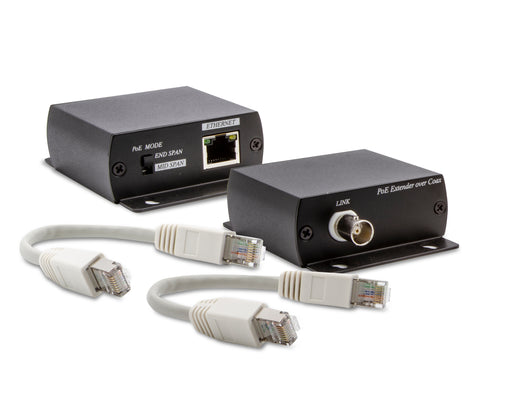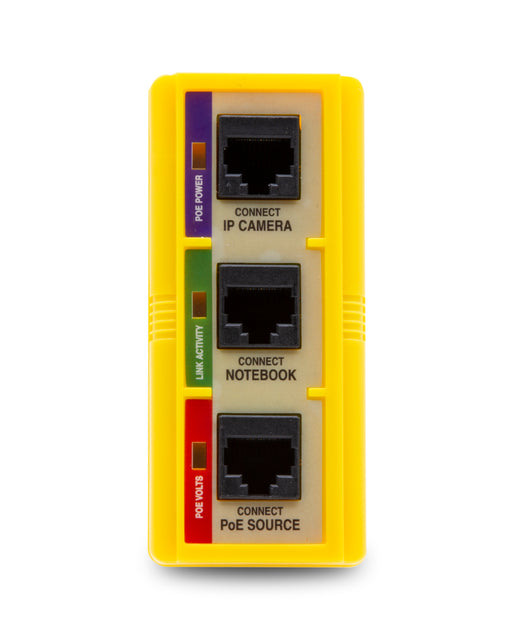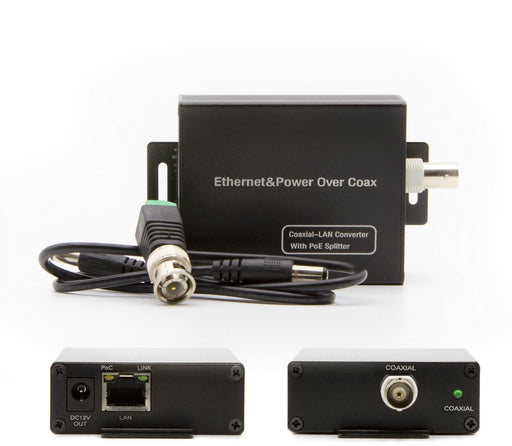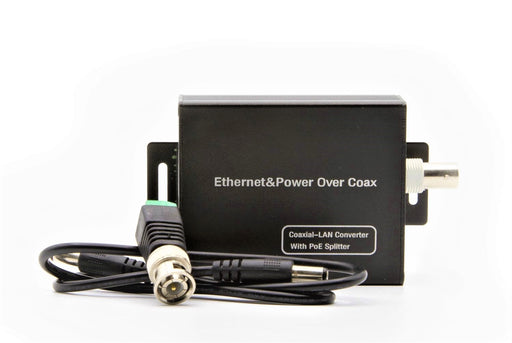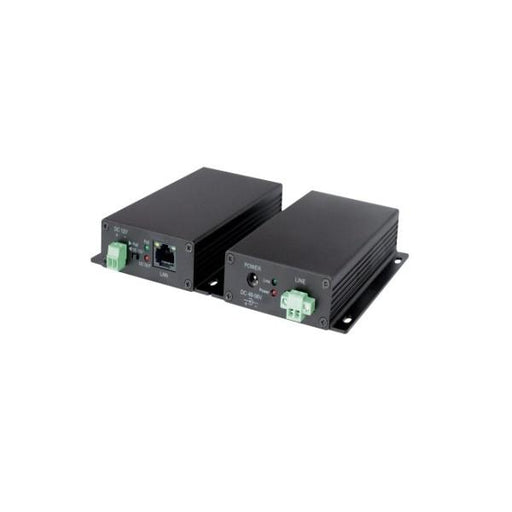
POE Testers
Triplett provides PoE testers that can detect PSE-type class, polarity, power source, voltage, power, and current, and so on in the PoE equipment. It helps detect whether the power source is Midspan (4/5, 7/8), End span (1/2, 3/6), or across all four pairs. It is also used for inline power monitoring. Our testers comply with IEEE 802.3af (PoE), IEEE 802.3 at (PoE+), and IEEE 802.3 bt (PoE+++) standards.
Power over Ethernet (PoE) is a technology that enables Ethernet cables to transmit power and data over the same cable. The power over Ethernet (PoE) tester is a device used to check power in Ethernet cables.
Filters
Categories
-
Building, Maintenance, and Environmental
- Borescopes & Inspection Cameras
- Laser Distance Meters
- Photo & Contact Tachometers
- Manometers
- CO & CO2 Meters
- F Connectors
- Combustible Gas Detector and Pen
- Humidity Indicators & Meters
- Pin & Pinless Moisture Meters
- Thermometers
- Light Meters
- Sound & Noise Level Meters
- Particle Counter
- Thermo Anemometers
- Hygro-Thermometers
- Hygrometer
- Special Kits
- Refractometer
- Coating Thickness Testers
- PH and Conductivity Meters
-
Electrical Test & Measurement
- Analog Meters -Voltmeters
- Clamp Meter
- Digital Multimeters
- Railroad Test Sets
- Voltage & Current Dataloggers
- Magnetic Field Detectors
- AC Voltage Detector
- Continuity Testers
- Test Leads
- Multimeter Case
- GFCI Receptacle Testers
- Electrical Hand Tools
- Non-Contact Voltage Detection Pens
- Circuit Breaker Tracers
- Special Kits
- Megohmmeters - Insulation Testers
- Power Supplies
- Motor & Phase Rotation Testers
-
Security, CCTV & Cabling Equipment
- Security Camera Testers
- CCTV HD LED Test Monitors
- Baluns, Ground Loop Isolators
- HDMI & IP Extenders
- All Cables
- HDMI Cables
- CAT6a Shielded Cable
- Ethernet Network Cables
- CCTV BNC Adapters
- BNC Connectors
- F Connectors
- BNC Compression Connectors
- CAT5 & CAT6 Connectors
- CCTV Coax Connectors
- Modular Connector
- Between Series Adapters
-
Original price $146.00 - Original price $146.00Original price$146.00$146.00 - $146.00Current price $146.00| /
PoE Tester Pro™ : Inline Power Over Ethernet Detector Detects PSE-Type/Class, Power Source and More - (POE2000)
TriplettIn stock0 Reviews
The POE2000 helps to speed up the installation and troubleshooting of PoE system devices. It can detect PSE-type/class, power source, polarity, vol...
View full detailsOriginal price $146.00 - Original price $146.00Original price$146.00$146.00 - $146.00Current price $146.00| / -
Original price $59.00 - Original price $59.00Original price$59.00$59.00 - $59.00Current price $59.00| /
Passive IP Extender Over Coax: Use Coax Cable to Send IP Camera Signal, Transmission Up to 984' - Pair - (POE-1TR)
GEM by TriplettIn stock0 Reviews
POE-1TR is a low cost and easy, speedy solution to allow you to use existing coax cable to send IP camera signal CATEGORY: POE TESTERS & EQU...
View full detailsOriginal price $59.00 - Original price $59.00Original price$59.00$59.00 - $59.00Current price $59.00| / -
Original price $189.00 - Original price $189.00Original price$189.00$189.00 - $189.00Current price $189.00| /
In-line PoE Tester Pro - (POE3000)
TriplettIn stockThe Triplett POE3000 In-Line PoE Tester Pro helps to speed up the installation and troubleshooting of PoE system devices. It can detect PSE-type/cl...
View full detailsOriginal price $189.00 - Original price $189.00Original price$189.00$189.00 - $189.00Current price $189.00| / -
Original price $88.00 - Original price $88.00Original price$88.00$88.00 - $88.00Current price $88.00| /
PoE Injector for Triplett 807X - (37-73)
TriplettLow stock0 Reviews
PoE Injector for Triplett 807X - (37-73)
Original price $88.00 - Original price $88.00Original price$88.00$88.00 - $88.00Current price $88.00| / -
Original price $88.00 - Original price $88.00Original price$88.00$88.00 - $88.00Current price $88.00| /
Inline PoE Surge Protector - (SP200)
TriplettIn stockThe Triplett Model SP200 is an Inline PoE Surge Protector is designed to protect valuable PoE devices in Educational Institutions, Server Farms, Ma...
View full detailsOriginal price $88.00 - Original price $88.00Original price$88.00$88.00 - $88.00Current price $88.00| / -
Original price $291.00 - Original price $291.00Original price$291.00$291.00 - $291.00Current price $291.00| /
PoE Extender over Coax 300M - (POC-300M)
Triplett Test Equipment & ToolsIn stock0 Reviews
The Triplett Model POC-300M is a PoE (Power over Ethernet) extender that can use coaxial cable to send the signal to any TCP/IP 10/100BaseT device ...
View full detailsOriginal price $291.00 - Original price $291.00Original price$291.00$291.00 - $291.00Current price $291.00| / -
Original price $73.00 - Original price $73.00Original price$73.00$73.00 - $73.00Current price $73.00| /
IP Answer Stick IP Camera PoE Tester: Align and Focus IP Camera at Camera Location - (IPAS10-N)
TriplettIn stockThe Triplett/ByteBrothers IPAS10-N IP Answer Stick is a must-have tool for IP camera installers. It allows users to align and focus the IP camera a...
View full detailsOriginal price $73.00 - Original price $73.00Original price$73.00$73.00 - $73.00Current price $73.00| / -
Best SellerOriginal price $262.00 - Original price $262.00Original price$262.00$262.00 - $262.00Current price $262.00| /
Power Over Coax Single Channel Transmitter - (POC-1TYNPOE)
GEM by TriplettIn stockPOC Single Channel Transmitter CATEGORY: POE TESTERS & EQUIPMENT, POWER OVER COAX Features Use with GEM POC-16PWP 16 port rack-mount Pow...
View full detailsOriginal price $262.00 - Original price $262.00Original price$262.00$262.00 - $262.00Current price $262.00| / -
Free Shipping*Original price $676.00 - Original price $676.00Original price$676.00$676.00 - $676.00Current price $676.00| /
Power Over Ethernet - (POE-PL602)
GEM by TriplettLow stockSingle Channel Power over Ethernet -- Power any pair, up to 46V. CATEGORY: POE TESTERS & EQUIPMENT Features Transmit Ethernet and Power ...
View full detailsOriginal price $676.00 - Original price $676.00Original price$676.00$676.00 - $676.00Current price $676.00| /
Know More About Triplett POE Tester
What is PoE testing?
PoE is an innovative technology used to power PoE-enabled devices and a wide range of network devices. Network technicians who have implemented PoE networks or maybe planning expansion use PoE testers to check the power performance of the power sourcing equipment (PSE) in the network. There are two types of PSEs – end span and mid-span. The end span devices use an Ethernet switch featuring an embedded power supply that delivers data and power. The IEEE Standard 802.3af permits these devices to supply power on different pairs of 4-pair copper cables. End span PSEs are compatible with 100 Base-TX, 10Base-T, and 1000Base-T data transmission. The mid-span devices work as standalone devices and they sit between routers or legacy switches and powered devices. Sometimes, these mid span devices are integrated into the patch panel.
How does a PSE system work?
PSEs run a discovery process to analyze if they are POE enabled and fit to receive power. During this discovery process, the PSE usually applies a small current limited voltage to the cable. It checks for the availability of a 25 kΩ resistors in the remote device. If this resistor is found in the remote device then the PSE applies 48V or up to a maximum 1s5W power as indicated by the PoE standard. This power is supplied as long as the device draws a minimum amount of current. The power supply is stopped by the PSE when it notices that the device is removed from the service. It restarts the discovery process again.
What does a Power Over Ethernet tester do?
The PoE tester usually checks the RJ-45 outlet of your device to identify whether it is powered by end span or mid span.
Benefits of Inline PoE Testers
Inline Power over Ethernet (PoE) testers are valuable tools for ensuring the proper operation and troubleshooting of PoE networks. They offer several benefits that contribute to the efficiency and reliability of PoE installations. Here are some key advantages of using inline PoE testers:
- Real-Time Monitoring: Inline PoE testers provide real-time monitoring of PoE parameters, such as voltage, current, and power consumption. This allows network administrators and technicians to instantly assess the health and performance of the PoE system.
- Quick Troubleshooting: When a powered device (PD) is not functioning correctly, inline PoE testers can quickly identify whether it's a power-related issue or a network problem. This speeds up troubleshooting and reduces downtime.
- Verification of Power Delivery: Inline testers verify that the correct amount of power is being delivered to the PD. They ensure that the voltage and current levels adhere to the PoE standard preventing underpowering or overloading.
- Class Detection: Many inline PoE testers can detect and display the PoE class of the connected device. This information is crucial for understanding the power requirements of the PD and ensuring compatibility with the power source.
- Power Consumption Analysis: These testers can measure and display the power consumption of the connected device. This helps in assessing whether the PD operates within its specified power budget.
- Quality Assurance: Inline testers can verify the quality of the power supplied to the PD. They check for voltage drops, fluctuations, and power spikes that could affect the device's operation.
- Prevent Overheating: By monitoring the power levels, inline PoE testers can prevent overheating of PDs due to excessive power delivery. Overheating can lead to device failures or reduced lifespan.
- Documentation: Inline testers often include data logging and recording capabilities, allowing users to document power-related information for future reference, audits, or compliance reports.
- Compatibility Testing: Some inline testers can simulate different PoE classes to test the compatibility of PDs with various power sources. This is particularly useful in mixed-device environments.
- Remote Monitoring: Advanced inline testers may offer remote monitoring capabilities, allowing network administrators to monitor PoE networks from a central location. This is valuable for large-scale installations.
- Verification of New Installations: During the installation of PoE devices or network upgrades, inline PoE testers ensure that power delivery is as expected, reducing the risk of post-installation issues.
- Efficient Maintenance: Routine maintenance of PoE networks becomes more efficient with inline testers. Technicians can quickly identify issues and take corrective action, minimizing network downtime.
Overall, inline PoE testers play a crucial role in ensuring the reliability and performance of PoE installations. They provide valuable insights into the health of PoE networks and help prevent power-related problems that can disrupt network operations.
How to use the PoE checker?
The usage of PoE checker will differ according to their design. Our tester requires no additional battery to operate as it uses the power of the system connected to it. You can use the tester following these steps.
- For determining PSE-type/class, polarity, voltage and power class, connect the tester to the RJ45 PSE test jack designed for PSE type tests. This test jack can be used to test PoE devices like PoE switches, PoE active/passive injectors, PoE mid span switches, and so on.
- For determining standard PoE or non-standard passive PoE, connect the tester to RJ45 PD test jack designed for PD tests. This test jack can be used to test power in IP cameras, IP phones, wireless AP, and other network devices.
- For monitoring the inline power, connect the device inline.
- After connecting the device, press the STEP button to select the specific test data for reading.
- Check the LED indicators on the panel in the front to identify power.
- Our panel comprises 4 LEDs that indicate IEEE 802.3 af or IEEE 802.3 at/bt standard.
- There are dual 7-digit LEDs that indicate power source either End (A) Span (1/2, 3/6) or Mid (B) Span (4/5, 7/8), or for both.
- There are 2 yellow LEDs that indicate reversed polarity for power type.
Browse More Network & Cable Testing Collections
Cable Testers:
| Voice, Data, & Video Patch Cables | Cable Length Meters | Tone Generator & Probe Kits |
| LAN or Ethernet Testers | Low Voltage Testers & Accessories |
Telephone Test Sets:
| Telephone Lineman Test Sets | Telephone Line Tester | Power Over Coax |
RF Spectrum Analyzer:
| RF Spectrum Analyzer |
Networking Hand Tools:
| Networking Hand Tools |

